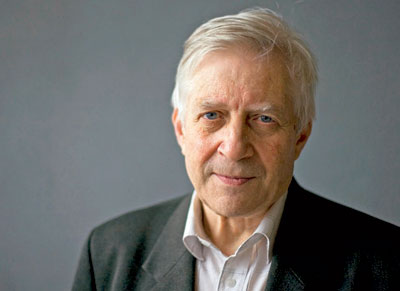 Nicolay Kardashev (Photo courtesy of Russian Academy of Sciences)
Nicolay Kardashev (Photo courtesy of Russian Academy of Sciences)
Nicolay Kardashev
Article contributed by Kenneth I. Kellermann
The Grote Reber Foundation is pleased to announce the award of the 2012 Grote Reber Gold Medal for innovative and significant contributions to radio astronomy to Acadamician Nicolay Kardashev, Director of the Russian Astro Space Center of the Lebedev Physical Institute in Moscow.
Over more than half a century, Professor Kardashev has made a series of innovative contributions that have greatly impacted the current state of radio astronomy. In 1958 he showed, contrary to previous calculations, that very highly excited atoms can give rise to radio emission at a series of discrete frequencies in the centimeter band. With Kardashev’s encouragement, two radio astronomy teams in Moscow and Leningrad were able detect the predicted atomic radio emission. His later research has focused on the evolution of radio galaxies, cosmology, and black hole physics.
He is also well known for his pioneering work on "super civilizations", which has become the basis for observational SETI programs over the past half century. Kardashev described how civilizations might progress to first harness the power from their planet (Type I), their sun (Type II), and ultimately their galaxy (Type III) to power radio transmitters for interstellar communications.
More than thirty years ago Kardashev proposed placing a radio telescope in space to form an interferometer system together with ground based radio telescopes. Political and technical conditions in the USSR resulted in very slow progress, which was further constrained by the fall of the USSR and the resulting difficult financial situation for Russian scientists. With the improved conditions of the past decade, Kardashev was able to raise the project to the highest priority in Russian space astrophysics. In July of this year RadioAstron was launched into an orbit extending up to 350,000 km from the Earth; this will give an unprecedented angular resolution as small as 10 microarcseconds. This will be by far the best resolution ever achieved in astronomy.
David Jauncey of the CSIRO Division of Astronomy and Space Science in Australia commented that "Professor Kardashev’s initiative with the launching of RadioAstron effectively opens a new window in high resolution astronomy."
Nicolay Kardashev has shown much the same disregard for conventional wisdom in theoretical astrophysics as Grote Reber did for experimental work. It is fitting that Kardashev’s RadioAstron spacecraft carries a plaque provided by the Grote Reber Foundation in memory of Grote Reber, who would have celebrated his 100th birthday on December 22, 2011.
The Grote Reber Medal was established by the Trustees of the Grote Reber Foundation to honor the achievements of Grote Reber and is administered by the Queen Victoria Museum in Launceston, Tasmania.
![[IAU logo]](iau_wb_thumb.jpg)
![[URSI logo]](URSI-logo-thumb.jpg)
![[Karl Jansky at his antenna]](jansky_photo_02_thumb.jpg)
![[Reber's Wheaton antenna]](Reber_Telescope_Wheaton_thumb.jpg)
![[Dover Heights]](Dover_Heights_02_thumb.jpg)
![[4C telescope]](GB61-195_4C_telescope_thumb.jpg)
![[Ewen and horn antenna]](ewen_horn1s.jpg)
![[Dwingeloo, 1956]](Dwingeloo-1956-thumb.jpg)
![[Jocelyn Bell Burnell and Cambridge antenna used in pulsar discovery]](burnell2_thumb.jpg)
![[Lovell Telescope at Jodrell Bank]](site_1594_0001-500-334-20180316163019-thumb150.jpg)
![[Wilson, Penzias, and Bell Labs horn antenna]](wilson-penzias-horn_thumb.jpg)
![[6-m Millimeter Radio Telescope in Mitaka, Japan]](6m-thumb.jpg)

